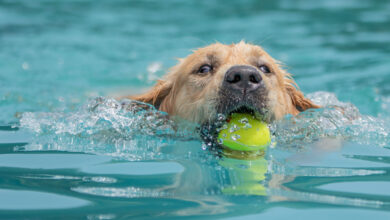
BY BERNADETTE ROBERTS
Labradors have long been considered one of the most versatile dog breeds, excelling in various roles, from working as hunting companions to performing search and rescue missions.
However, one of the most profound and life-changing roles that Labradors have filled is that of a guide dog for the blind. Their unwavering loyalty, intelligence, and calm demeanour have made them the ideal choice for individuals with visual impairments. In this article, we explore the history of Labradors being used as guide dogs, when this groundbreaking use first came about, and why these dogs are so perfectly suited for this role.
The Origins of Guide Dogs
The history of guide dogs dates back to the early 20th century, with the first organized guide dog training for the blind beginning in Germany in the 1910s. The development of guide dogs was inspired by a desire to improve the independence and mobility of individuals who were visually impaired. Prior to the use of guide dogs, the blind relied heavily on white canes and the assistance of others. Although helpful, these tools did not provide the same level of autonomy that a guide dog could offer.
The initial training of guide dogs began during World War I, when many soldiers returned home with injuries that resulted in blindness. The German government saw the potential for dogs to help these soldiers regain their independence and began to train and pair dogs with the blind. These dogs were trained to help their handlers navigate obstacles and avoid danger, as well as provide emotional support and companionship.
The Role of Labradors in Guide Dog Training
While the initial use of guide dogs in Germany and the United States involved breeds like German Shepherds and Collies, it wasn’t long before Labrador Retrievers became a popular choice for the role of guide dog. Labradors have the perfect combination of traits that make them highly suitable for guide dog work, which is why they are now the most commonly used breed in this capacity worldwide.
Labradors are known for their friendly, outgoing, and calm nature. They are generally non-aggressive, social, and eager to please, making them easy to train and work with. This temperament is particularly important for guide dogs, as they need to maintain a gentle yet confident demeanour when guiding their handler.
Additionally, Labradors are highly intelligent dogs, which is essential for the complex task of guiding a blind person. A guide dog must be able to recognize various commands, respond to changes in the environment, and make decisions based on the handler’s needs. Labradors excel in these areas due to their quick learning ability and their natural problem-solving skills.
Their strong, agile, and physically capable bodies are also critical for guide dog work. A Labrador must be able to walk long distances, navigate obstacles, and keep pace with their handler. Their size is also ideal; they are large enough to offer support but not so large that they would impede movement or be difficult to handle.
Moreover, Labradors are extremely trainable, which is why they are often chosen for service roles. Guide dogs need to learn a wide range of tasks, from avoiding obstacles to guiding their handler to specific locations. Labradors are not only intelligent but also willing to work hard for their handler, making them ideal candidates for training programs.
The First Guide Dog Training Schools
The first guide dog training schools were established in the 1920s, and Labradors quickly became a preferred breed for guide dog schools due to their temperament and trainability. The first successful training program for guide dogs was developed by Dorothy Eustis, an American dog trainer who founded the first guide dog school in Switzerland in 1924. The school, called the “Seeing Eye,” was established to train dogs to guide people who were blind.
While the Seeing Eye program initially used German Shepherds for their training, it wasn’t long before Labradors began to make their mark as guide dogs. Their steady temperament and ability to work with people made them an ideal choice for training programs in the United States and Europe. By the 1930s, the use of Labradors as guide dogs became widespread.
The Expansion of Guide Dog Services in the UK
The use of Labradors as guide dogs for the blind spread to the UK in the 1930s, where the first formal guide dog training program was established by The Guide Dogs for the Blind Association (GDBA). Founded in 1934 by Sir Edmund DuCane, the GDBA was the first charity in the UK to offer guide dogs to people with visual impairments. Labradors, along with German Shepherds and other breeds, began to be trained and paired with individuals in need.
Over time, Labradors became the breed of choice for guide dog work in the UK as well. The GDBA’s success in training Labradors to guide people with visual impairments set the standard for guide dog programs across the world. The association continues to this day, providing thousands of guide dogs to those in need.
Labradors in Modern Guide Dog Training
Today, Labradors remain the most commonly used breed for guide dog training, although other breeds such as Golden Retrievers and crosses of the two are also popular. Guide dog schools and organizations worldwide, including the Guide Dogs for the Blind Association in the UK and the Seeing Eye in the United States, continue to rely heavily on Labradors for their remarkable abilities and temperament.
Modern guide dog training programs typically begin when the dog is a puppy. After socialization and early obedience training, the dogs are taught specific tasks to help their handlers, such as stopping at curbs, avoiding obstacles, and navigating through crowds. The training is rigorous and can take up to two years before the dog is fully prepared to guide their handler safely and efficiently.
Once fully trained, the guide dog is paired with their handler, and the two form a unique bond that allows the handler to regain a level of independence they might not have had before. The Labrador guide dog helps its handler not only navigate the world but also provides emotional support and companionship, offering comfort and security.
The history of Labradors as guide dogs is a story of dedication, innovation, and the incredible bond between humans and dogs. These remarkable animals have played a significant role in improving the lives of people who are blind or visually impaired. Their intelligence, trainability, calm demeanour, and physical capabilities make them the ideal candidates for the demanding work of guiding a blind person through the world.
From the first organized training programs in Germany in the early 20th century to the widespread use of Labradors as guide dogs today, these dogs have proven time and again that they are more than just companions—they are lifesavers. As the most commonly used breed for guide dog training worldwide, Labradors continue to bring independence and freedom to thousands of people every year, demonstrating why they are truly one of the best breeds for the job.




